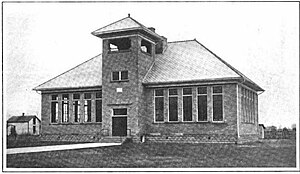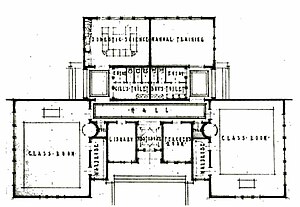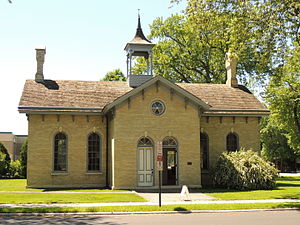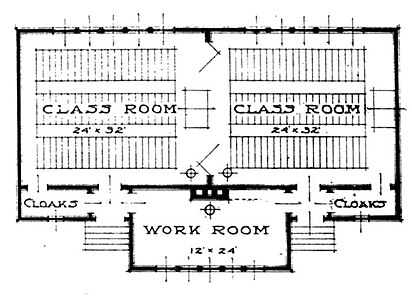
One-room schools, or schoolhouses, were commonplace throughout rural portions of various countries, including Prussia, Norway, Sweden, the United States, Canada, Australia, New Zealand, the United Kingdom, Ireland, and Spain. In most rural and small town schools, all of the students met in a single room. There, a single teacher taught academic basics to several grade levels of elementary-age children. While in many areas one-room schools are no longer used, some remain in developing nations and rural or remote areas.

Chana School is a Registered Historic Place in Ogle County, Illinois, in the county seat of Oregon, Illinois. One of six Oregon sites listed on the Register, the school is an oddly shaped, two-room schoolhouse which has been moved from its original location. Chana School joined the Register in 2005 as an education museum.

The John A. Lafevre House and School is located along NY 208 in the town of Gardiner, New York, United States. It is often believed to be in New Paltz as it is within that town's ZIP Code. The house is a stone structure dating to 1772; the school was built in 1835 and remained in use for almost a century. Both are well-preserved examples of their type of building and were listed on the National Register of Historic Places in 1989.

The Charter Oak Schoolhouse is a historic octagonal school building in Schuline, Illinois, located on the Evansville/Schuline Road between Schuline and Walsh. Built in 1873, it served as a public primary school until 1953. The school was one of 53 octagonal schoolhouses built in the United States, of which only three survive. The building is now used as a museum by the Randolph County Historical Society and is listed on the National Register of Historic Places.

The Walnut Street School is a historic school building at 55 Hopkins Street in Reading, Massachusetts. A two-room schoolhouse built in 1854, it is the town's oldest public building. Since 1962 it has been home to the Quannapowitt Players, a local theatrical company. The building was listed on the National Register of Historic Places in 1984.

The South School is a historic one-room schoolhouse at 6 Schoolhouse Rd. in Shutesbury, Massachusetts. It is one of two such schoolhouses remaining in Shutesbury, and is a rare example of a side-gable construction. Its date of construction is uncertain, but is estimated to be about 1830. Because of the simplicity of the building, the presence of both Federal and Greek Revival elements in its design, and the comparatively late adoption of Greek Revival styles in the rural community, the school may have been built at a later date.

The District #2 Schoolhouse, known locally as the Garfield School and also known as Brunswick District No. 2 School, located in Brunswick, New York, United States, is a two-room schoolhouse built and opened in 1881. It hosted local students until the consolidation of Brunswick (Brittonkill) Central School District in the mid-1950s. It was added to the National Register of Historic Places (NRHP) in 1988, becoming the first building in the Town of Brunswick to be added to the Register. It is the current home of the Brunswick Historical Society.
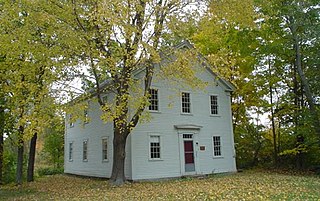
The Square Schoolhouse is a historic schoolhouse at the junction of New Hampshire Route 156 and Ledge Hill Road in Nottingham, New Hampshire. Built about 1850, it is one of the best-preserved mid-19th century schoolhouses in southern New Hampshire. It served as a school until 1920, and is now a local museum. It was listed on the National Register of Historic Places in 1980. It is named not for its shape, but for its location in Nottingham Square.

The Lower Sunday River School is an historic school on Sunday River Road, just north of its junction with Skiway Road, in Newry, Maine. Built in 1895 by the town, this is one of the best-preserved one-room schoolhouses in northern Oxford County. The school was listed on the National Register of Historic Places in 1978.

The Eggleston School is former school and current private residential structure located at the 10539 Nolan Road in rural Nester Township in southeastern Roscommon County, Michigan. It was designated as a Michigan Historic Site on February 29, 1996, and soon after added to the National Register of Historic Places on April 4, 1996. The school is particularly notable for the finely crafted fieldstone exterior, constructed of blocks with various shapes, sizes, and hues. It is the only property in Roscommon County listed on the National Register and one of only four county properties designated as a Michigan Historic Site — along with Gerrish Township Information Site, Pioneer House, and Turney House.

The District No. 5 School is an historic school building and local history museum at 2 Old Mill Road in Shrewsbury, Massachusetts. It is one of two relatively unmodified one-room schoolhouses in the town. Built in 1828, the brick schoolhouse is also one of the oldest surviving school buildings in the state. The building was listed on the National Register of Historic Places in 2013.
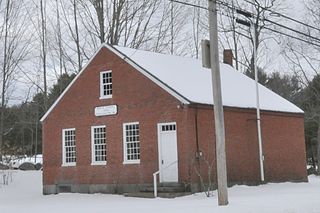
The North School, also known locally as the Brick School, is a historic one-room schoolhouse at 63 Amesbury Street in Kensington, New Hampshire, United States. Built in 1842, it was the only brick schoolhouse built in the town, and is one of its four surviving 19th-century schools. Of those, it is the best-preserved, and is used as a local history museum. It served the town's educational purposes between 1842 and 1956, and is now a local history museum. The building was listed on the National Register of Historic Places in 2013.

The District No. 9 Schoolhouse is a historic school building at 358 Hoyt Road in Gilford, New Hampshire. Built in 1815 and repeatedly altered to accommodated changing trends in school design, it is the best-preserved of Gilford's surviving district schoolhouses. Now a private summer residence, the building was listed on the National Register of Historic Places in 2000.
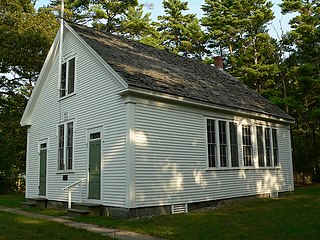
The Division No. 9 School is a historic former one-room schoolhouse on Maine State Route 9 in Wells, Maine. Built in 1900, it is the best-preserved of the town's surviving district school buildings, and is now a museum owned by the town. It was listed on the National Register of Historic Places in 1995.
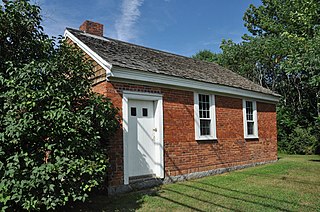
The Brick School is a historic one-room schoolhouse on Cushman Road in Winslow, Maine. Built about 1810, it is one of the oldest surviving district schools in the state of Maine. It was listed on the National Register of Historic Places in 1977, and is now owned and maintained by the town's historic preservation committee

Highlandville School, also known as Highlandville Village School, is a historic structure located in the unincorporated community of Highlandville, Iowa, United States. It was built in 1911, replacing a 1904 building that was destroyed in a fire. The frame building follows a broad T-plan. The top of the T is a two-room rectangular section capped with a hip roof. A single-room, central projecting gable-front with a belfry forms the T's upright. The front section was used an entryway/coatroom, while the two-room back section housed the classrooms. The frame structure rests on a limestone basement. An entrance ramp replaces the original entrance steps. Two privies, which share the historic designation, are located to the north of the main building. The school was operated independently until 1960, and it closed in 1964. It stands as a reminder of the state of Iowa's determination to educate its citizens, particularly in the rural areas. It is also a unique rural two-room schoolhouse in Winneshiek County. The building was listed on the National Register of Historic Places in 2014.
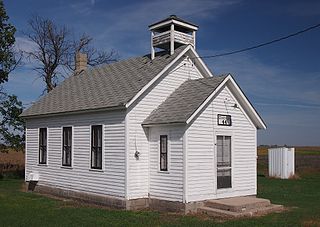
District No. 44 School is a historic one-room school in Taylor Township, Minnesota, United States. It was built in 1891 and used until 1954. The school building was listed on the National Register of Historic Places in 2011 for having local significance in the theme of education. It was nominated for being a well-preserved example of the one-room schoolhouses once common in rural Traverse County.

The Brock Hill Schoolhouse is a historic one-room schoolhouse on North Road in rural Newbury, Vermont. Built in 1850, it is a well-preserved example of a mid-19th century schoolhouse with Greek Revival styling. It was listed on the National Register of Historic Places in 2003.

The Alpine Elementary School is a compound consisting of four buildings in Alpine, Arizona, operated by the public Alpine Elementary School District on the Navajo Nation. It serves grades K-8. The original school building of this complex was built in 1930, but a government-funded school had operated here since 1882. The current gym/auditorium was constructed in 1939 for use as a chapel of The Church of Jesus Christ of Latter-day Saints, which had members in the community.

The Galen Elementary School is a historic building in Macon County, Tennessee. It was built by Jimmy Bohanon in 1928–29. It was a two-year feeder high school until 1960, when it closed down. One of the teachers was Harold Blankenship, who was interviewed in 1991. The building has been listed on the National Register of Historic Places since February 22, 1993.

